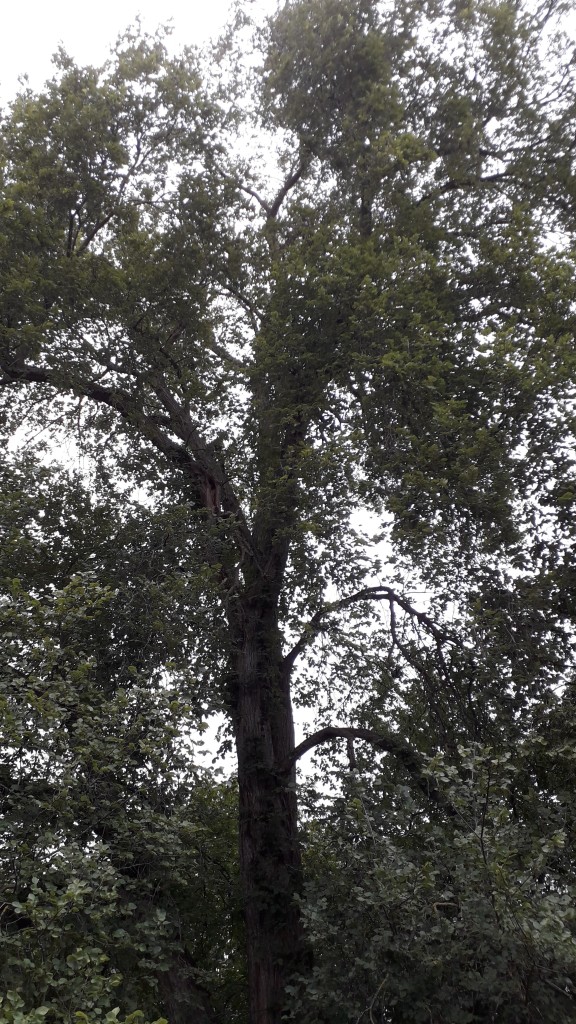Walking in south-east London last weekend, I found myself looking up at a magnificent Dutch elm tree. I’ve been looking for elms for years. Mature elms are rare in the UK, of course, having been all but wiped out by the Dutch elm disease of the 1960s and 70s – said to have destroyed around 20 million trees. Seeing this living tree, I thought of the lost medieval town of Dunwich, which W.G. Sebald describes disappearing into the sea in The Rings of Saturn. Like the lost bell of the church ringing outwards into our present.

Recently, I’ve been reading the twentieth-century Russian poet, Anna Akhmatova. Looking back on her youth, she wrote:
“Man’s voice held no sweetness for me,
Anna Akhmatova, ‘Willow’ (1940)
but I understood the wind.
I loved the burdock and the nettles
But above all the silver willow. […]
Strange – I outlived it.
A stump grows there now…”
This put me in mind of other poems about trees. In her poem, ‘The Black Walnut Tree’, the late American poet Mary Oliver debates with her mother whether to sell their old walnut tree to the lumberman. For the sake of their “fathers out of Bohemia/ filling the blue fields/ of fresh and generous Ohio,” they can’t bring themselves to have it felled, “so the black walnut tree/ swings through another year/ of sun and leaping winds […] and month after month, the whip-/ crack of the mortgage.”
Seamus Heaney, in the sonnet cycle ‘Clearances’ – written after his mother died in 1984 – describes an old chestnut he had grown from a jam-jar as a child: “…the crack and sigh/ And collapse […]/ the shocked tips and wreckage of it all” (‘Clearances 8’). In a visionary poem ‘The Wishing Tree’, from the same collection, he imagines his mother as a tree lifted into heaven:
“Trailing a shower of all that had been driven
Need by need by need into its hale
Sap-wood and bark: coin and pin and nail
came streaming from it like a comet tailNew-minted and dissolved…”
Heaney, ‘The wishing Tree’ from The Haw Lantern (1987)
‘…If it dies, it brings forth much fruit’:
What might we learn from these poets? From Akhmatova (the most tragic, and in some ways romantic of the three), a sense of the hard cycle of her own life set against the tree; from Mary Oliver also, independence and doggedness of spirit. And from Heaney, his great gift for elegy. From all three, the restorative power of the landscape; a love of the natural world for its own sake. All seem to prefer to see a tree standing, but should one fall, it will deliver up certain secrets, a full measure shaken together and pressed down, in proportion to the gifts of each poet.
At times it seems there’s a certain synchronicity or grace that sustains us – the way trees are not entirely singular, but essentially live in communities. It is now known, for instance, that groups of trees can feed each other through their root systems.
This poem is for my sister on her birthday.
After Anna Akhmatova
“Strange – I outlived it.”
You came back, all seemed
re-arranged. Familiar cherries
no longer standing. The reddish
glossy bark – a brief synaptic-
flash. Where you moved –
the mirror was heavy, but not the light.
The North Sea is not the Atlantic.
Still, a child now is dreaming | through
the face you held at five.
*
The saplings we planted
in late-adolescence – the birch
and mountain ash – are thick-
set now, less easily swayed. Though
the Atlantic is not the Pacific:
the mirror is heavy | not the light.
References:
I previously wrote about Seamus Heaney here: https://benedictgilbert.com/2020/07/21/known-and-strange-things-two-poems-by-seamus-heaney/
Anna Akhmatova, Selected Poems, Trans. Richard McKane (Penguin, 1969)
Mark Strand & Eavan Boland (Eds.), The Making of a Poem (Norton, 2000)
Seamus Heaney, The Haw Lantern (Faber, 1987)
Further reading: Elaine Feinstein’s excellent biography, Anna of All the Russias (2005), is well-worth reading.
You can find the tree here: https://ladywellfields.blogspot.com/p/tree-walk.html
© Benedict Gilbert 2020